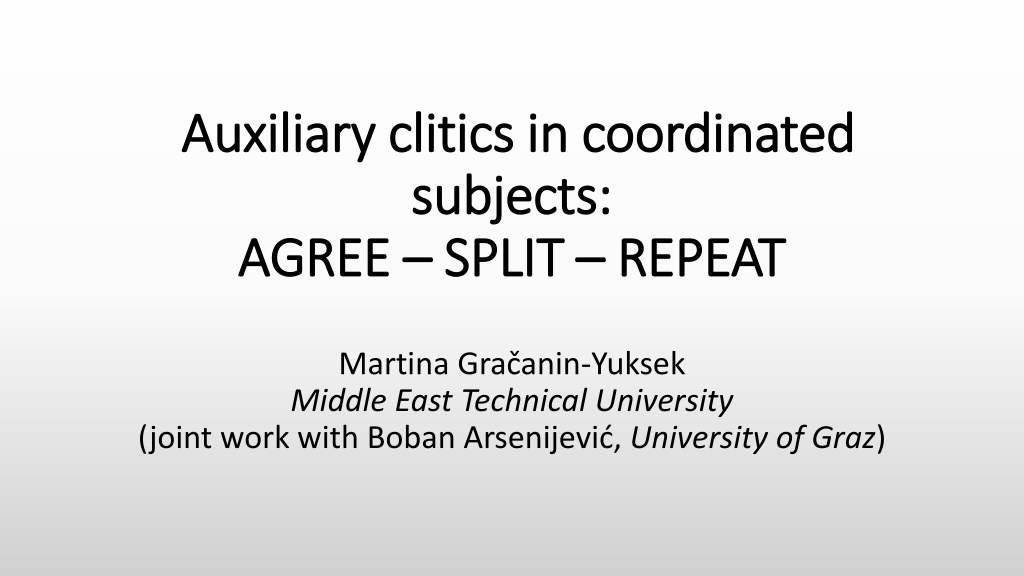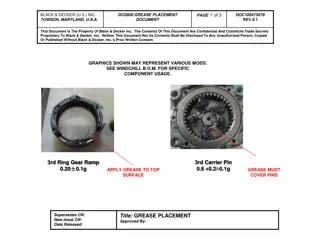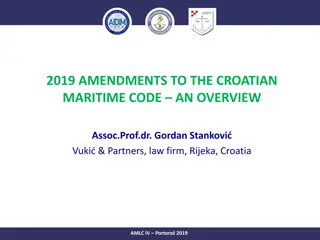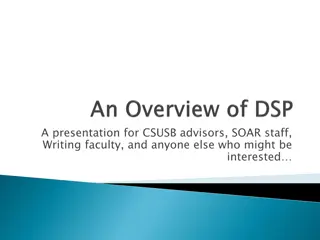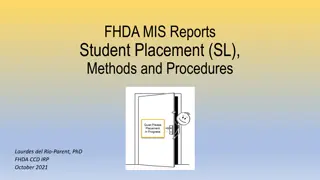Understanding Clitic Placement in Bosnian/Croatian/Serbian
This examination delves into configurations in Bosnian/Croatian/Serbian (B/C/S) language where the tensed verb acts as an auxiliary clitic, positioned either after or inside the first conjunct. It analyzes agreement phenomena involving auxiliary verb clitics and explores different values of features that shed light on the nature of agreement in these languages, highlighting that agreement is a multi-step process. The study also discusses the placement mechanisms of clitics in syntax, with a focus on right-adjoining the clitic to the left daughter. Moreover, the grammaticality of clitic placement in coordination structures is investigated, showcasing intriguing patterns in B/C/S.
Download Presentation

Please find below an Image/Link to download the presentation.
The content on the website is provided AS IS for your information and personal use only. It may not be sold, licensed, or shared on other websites without obtaining consent from the author. Download presentation by click this link. If you encounter any issues during the download, it is possible that the publisher has removed the file from their server.
E N D
Presentation Transcript
Auxiliary Auxiliary clitics clitics in coordinated in coordinated subjects: subjects: AGREE AGREE SPLIT SPLIT REPEAT REPEAT Martina Gra anin-Yuksek Middle East Technical University (joint work with Boban Arsenijevi , University of Graz)
Overview of the talk This talk examines configurations in Bosnian/Croatian/Serbian (B/C/S) in which: (i) The tensed verb is an auxiliary clitic, (ii) The clitic is placed after or inside the first conjunct. 1. [Direktor e manager will and his secretary come-late The manager and his secretary will be late. i njegov tajnik] zakasniti. 9/12/2017 FDSL 12.5 2
Overview of the talk We argue that examinations of configurations like (1) with different values of -features on the clitic (PL) and the first conjunct (SG) support a view of agreement on which: It is not a monolithic phenomenon, but rather involves multiple steps (Franck et al., 2006), It is sensitive to the kind of information that reveals it as a syntactic, rather than post-syntactic phenomenon (contra Bobaljik 2006, Arregi & Nevins 2007, Maru i et al. 2007, 2015, among others). 9/12/2017 FDSL 12.5 3
The puzzle In B/C/S, weak forms of auxiliary verb biti to be are second position clitics. Clitics can follow either the first phrase (1P) or the first word (1W) of the clause. 2. [Moj prijatelj] je kupio novi auto. my friend aux bought new car My friend bought a new car. 3. [Moj je prijatelj] kupio novi auto. my aux friend bought new car 9/12/2017 FDSL 12.5 1P 1W 4
An assumption: Clitic placement mechanism We assume that the position for the clitic is determined in syntax, by an algorithm in (4), which takes as a starting point the root of the tree and applies arbitrarily many times (Danny Fox, p.c.). 4. Right-adjoin the clitic to the left daughter (provided the operation is not string-vacuous). 9/12/2017 FDSL 12.5 5
Clitic placement mechanism: illustration 5. &P NP D0 my T NP AUX.cl friend T0 VP AUX.cl . . . 9/12/2017 FDSL 12.5 6
The puzzle Interestingly, the 1W placement is grammatical even when the first phrase is a coordination (Franks 2007, Mitrovi 2016; contra Bo kovi 2001, Diesing & Zec 2017). 6. [Cure ei de ki ] pospremiti sobu. girls will and boys tidy-up room Girls and boys will tidy up the room. 7. [Studenti bi students would and professors sat at same table Students and professors would sit at the same table. i profesori] sjedili za istim stolom. 9/12/2017 FDSL 12.5 7
The puzzle However, 1W placement of a clitic in a sentence with coordinated subject is not always well-formed. If the form of the clitic does not match the -features of the first subject, the sentence is degraded. 8. a. [Ja i moj mu ] emodo i u utorak. I and my husband will.1pl come in Tuesday Me and my husband will come on Tuesday. b. ??[Ja emoi moj mu ] I.1sg will.1pl and my husband come in Tuesday 1P do i u utorak. 1W 9/12/2017 FDSL 12.5 8
The puzzle Why does the auxiliary, which has already undergone agreement with the phrase in [Spec TP], seem to care about agreement with its phonological host? 9/12/2017 FDSL 12.5 9
The analysis: Background Agreement and the position of the subject Guasti and Rizzi (2002) note that cross-linguistically, agreement with preverbal subjects is more robust and less prone to variation than agreement with postverbal subjects. They propose that this is because features that are checked in overt syntax are expressed in the morphology, while those that are checked at LF may, but do not have to be expressed morphologically. 9/12/2017 FDSL 12.5 10
The analysis: Background Agreement and the position of the subject Guasti and Rizzi take [Spec TP] to be the position where the subject checks the agreement features on T0. If the subject makes it to [Spec TP] in overt syntax, agreement must be expressed morphologically. If the subject remains in some lower position in overt syntax, then the agreement feature on T0 is checked at LF and the morphological reflex of the operation is not obligatory. 9/12/2017 FDSL 12.5 11
The analysis: Background Agreement and the position of the subject 9. a. [Le tu sorelle] le son venute the your-FEM-PL sisters they are come-FEM-PL Your sisters came. b. Gl e venuto [le tu sorelle] it is come the your-FEM-PL sisters Fiorentino (Examples adapted from Brandi and Cordin 1989) 10. a. [ Al-awlaad-u] naamuu. the children slept-3MASC-PL The children slept. b. Naama [l- awlaad-u]. slept-3MASC-SG the children Standard Arabic (Examples from Aoun, Benmamoun, and Sportiche 1994) 9/12/2017 FDSL 12.5 12
The analysis: Background Agree and agreement verification Building on this observation, Franck et al. (2006:180-181) propose that agreement with postverbal subjects (in their analysis, subjects in [Spec vP]) is different from agreement with preverbal subjects (subjects in [Spec TP]). Agreement with postverbal subjects involves only Agree, an operation which copies the features of the goal onto the c- commanding probe. Agreement with preverbal subjects involves an additional verification step, which takes place after the movement of the subject to [Spec TP]: a comparison of the feature values between T0 and [Spec TP]. 9/12/2017 FDSL 12.5 13
The analysis: Background Agree and agreement verification 11. Agree 12. Verification 9/12/2017 FDSL 12.5 14
Proposal Agree and verification We propose that the operation of agreement verification can explain our puzzling clitic-agreement data. The clitic is originally inserted in T0, where it enters Agree with the coordinated subject in [Spec vP] values of -features of &P are copied onto T0. After the subject raises to [Spec TP], agreement verification step happens between it and T0. Crucially, we argue that this step also happens after the 1W placement of the clitic: the clitic enters agreement verification with its host. 9/12/2017 FDSL 12.5 15
Proposal: Agree and verification Consider (13): The entire &P is 2pl (since one of the conjuncts is the 2pl pronoun vi you.pl ) clitic is also 2pl (the value it acquired from &P via Agree). Since the first conjunct is 3pl (djeca children ), 1W placement is degraded, as snown in (13b). 13. a. [Djeca i vi ] ete nastaviti dalje. children and you.2pl will.2pl continue further The children and you will go on. b. ??[Djeca ete i vi] nastaviti dalje. 1W children.3pl will.2pl and you.2pl continue further 1P 9/12/2017 FDSL 12.5 16
Proposal: Agree and verification However, if the order of the conjuncts is reversed, as in (14), where the first conjunct is the 2pl pronoun vi you.pl , the 1W placement of the clitic is allowed, as shown in (14b). 14. a. [Vi i djeca] ete nastaviti dalje. 1P you.2pl and children will.2pl continue further You and the children will go on. b. [Vi ete i djeca] nastaviti dalje. you.2pl will.2pl and children continue further 9/12/2017 FDSL 12.5 1W 17
Proposal: Agree and verification The contrast of (14b) with (13b) suggest that upon its 1W placement, the clitic indeed enters another agreement- like relation this time with its host, in our case, the first conjunct. The well-formedness of (14b) shows that the placement of the clitic after the first conjunct of a &P is good when the -features of the first conjunct are identical to the - features of the entire &P (the first conjunct is plural and is the same grammatical person as the entire coordinated subject). 9/12/2017 FDSL 12.5 18
Refinement I: Morphological verification There is, however, another situation in which the 1W placement of the clitic yields a well-formed outcome. This is when the first conjunct is singular, but the form of the clitic required by the entire &P (plural) is syncretic with the form required by the singular first conjunct. 9/12/2017 FDSL 12.5 19
Refinement I: Morphological verification This situation is exemplified in (15). The form of the 3rd person plural future auxiliary, required by the coordinated subject in (15) is the same as its singular counterpart, required by the first conjunct, as shown in (16). 15. [Sestra i njezin mu ] edo i u utorak. [sister and her husband]3pl will.3sg/pl come in Tuesday The sister and her husband will come on Tuesday. 16. Sestra edo i u utorak. sister.3sg will.3sg/pl come in Tuesday The sister will come on Tuesday. 9/12/2017 FDSL 12.5 20
Refinement I: Morphological verification In this case, the 1W placement is well-formed. 17. [Sestra ei njezin mu ] do i u utorak. [sister.3sg will.3sg/pl and her husband] come in Tuesday The sister and her husband will come on Tuesday. 9/12/2017 FDSL 12.5 21
Refinement I: Morphological verification Given that syncretism of morphological forms ameliorates agreement verification violations, it seems that agreement verification does not check whether the - values on T0 are identical with the -values of the first conjunct. Instead, it seems to check whether the morphological form of the clitic is compatible with the -features of its host MORPHOLOGICAL verification. 9/12/2017 FDSL 12.5 22
Refinement II: Locus of verification If this proposal is on the right track, morphological verification is not limited to the phrase occupying [Spec TP] since 1W position of the auxiliary clitic is arguably not T0; we speculated that the clitic is right-adjoined to its phonological host (first conjunct). We propose that T0 enters morphological verification with the closest phrase that c-commands it (symmetrically or asymmetrically). 9/12/2017 FDSL 12.5 23
Refinement II: Locus of verification Finally, if morphological verification is the only verification mechanism in the grammar (if what Franck et al. (2002) call agreement verification is in fact morphological verification), then it is potentially recursive. T0 always undergoes morphological verification with the subject phrase in [Spec TP]. However, if T0 moves (as is the case with clitics) morphological verification happens every time a new configuration is established. 9/12/2017 FDSL 12.5 24
An illustration: A case of morphological match Recall that one case in which 1W placement of the clitic yields a well-formed sentence is when the -features of the first conjunct are identical to the -features of the entire &P. 14. a. [Vi i djeca] ete nastaviti dalje. 1P you.2pl and children will.2pl continue further You and the children will go on. b. [Vi ete i djeca] nastaviti dalje. you.2pl will.2pl and children continue further 1W 9/12/2017 FDSL 12.5 25
An illustration: A case of morphological match 18. [You.2PL will.2PL and the children]2PL come. TP &P.2pl T Cl. will vP [You.2pl and children] will.2pl &P.2pl v MV MV Agree [you.2pl and children] 9/12/2017 FDSL 12.5 26
An illustration: A case of morphological mismatch However, when the the -features of the first conjunct (djeca children 3pl), are different from the -features of the entire &P (2pl), morphological mismatch obtains, and the 1W placement is degraded. 13. a. [Djeca i vi ] ete nastaviti dalje. children and you.2pl will.2pl continue further The children and you will go on. b. ??[Djeca ete i vi] nastaviti dalje. 1W children.3pl will.2pl and you.2pl continue further 1P 9/12/2017 FDSL 12.5 27
An illustration: A case of morphological mismatch 19. ??[Children.3PL will.2PL and you]2PL come. TP &P.2pl T Cl. will vP [Children.3pl and you] will.2pl &P.2pl v MV MV Agree [Children.3pl and you] 9/12/2017 FDSL 12.5 28
An illustration: A case of syncretic match Finally, if the -features of the first conjunct (sestra sister 3sg), are different from the -features of the entire &P (3pl), but agreement with either yields the same form of the clitic, 1W placement of the clitic is well-formed. 15. [Sestra i njezin mu ] edo i u utorak. [sister and her husband]3pl will.3sg/pl come in Tuesday The sister and her husband will come on Tuesday. 16. [Sestra ei njezin mu ] do i u utorak. [sister.3sg will.3sg/pl and her husband] come in Tuesday The sister and her husband will come on Tuesday. 1P 1W 9/12/2017 FDSL 12.5 29
An illustration: A case of syncretic match TP 20. [Sister.3SG will.3SG/PL and her husband]3PL come. &P.3pl T Cl. will will.3sg/pl vP [Sister.3sg and her husband] &P.3pl v MV Agree MV [sister.3sg and her husband] 9/12/2017 FDSL 12.5 30
Interim summary We adopt the non-monolithic view of agreement, where Agree (which takes place under c-command) is supplemented by the operation of agreement verification, which takes place between a head and the most local phrase that (a)symmetrically c-commands it (is not restricted to T0). Agreement verification is morphological in nature, i.e., applies late in the derivation, following lexical insertion: Well-formedness of examples that involve the form of the clitic which is syncretic between the form agreeing with the whole &P and the one agreeing only with the first conjunct. If morphological verification is the only kind of verification process in the grammar, it is recursive (happens before and after the 1W placement of the clitic). 9/12/2017 FDSL 12.5 31
Morphological verification is late: NOM-ACC syncretic objects Mismatches in morphological verification are sensitive to case: when the &P, and consequently the 1st conjunct, is non-nominative (hence does not agree with T0), mismatches do not give rise to degradation, as shown in (21). (21) a. [Sestru sister.ACC.3SG will.1PL and her.ACC husband.ACC visit in Tuesday (We) will visit the sister and her husband on Tuesday. emo i njenog mu a] posjetiti u utorak. b. [Poznatog famous.ACC.3SG aux.3PL actor.ACC and his.ACC wife.ACC seen in Vienna (They) saw the famous actor and his wife in Vienna. su glumca i njegovu enu] vidjeli u Be u. 9/12/2017 FDSL 12.5 32
Morphological verification is late: NOM-ACC syncretic objects However, when the coordinated object phrase (and therefore, the first conjunct) looks like nominative (due to the NOM-ACC syncretism), the degradation of 1W placement of the clitic reemerges. (22) a. [??Dijete ste child.ACC/NOM.3SG aux.2PL and girl.ACC/NOM disappointed. (You.pl) disappointed the child and the young girl. i djevoj e] razo arali. b. [??Tele calf.ACC/NOM.3SG aux.3PL and puppy.ACC/NOM sold (They) sold the calf and the puppy. su i tene prodali.] The contrast between (21) unequivocal ACC of the &P and (22) ACC syncretic with NOM lends support to the claim that the verification process is late, i.e., that it applies after lexical insertion. 9/12/2017 FDSL 12.5 33
Morphological verification is late: DP-internal agreement Another piece of evidence for the late application of MV comes from 1W placement of clitics when the first conjunct is syntactically complex and contains pre-nominal elements that agree with the noun. 23. [Mla a sestra i ti] etedo i kasnije. [younger.FEM.3SG sister.FEM.3SG and you will.2PL come later My sister and you will come later. 1P 24. ??[Mla a [younger.FEM.3SG will.2PL sister.FEM.3SG and you come later etesestra i ti] do i kasnije. 1W The degradation of (24) shows that MV follows DP-internal agreement processes, i.e., that it happens relatively late in the derivation. 9/12/2017 FDSL 12.5 34
Morphological verification is late: Wrap up MV must apply late in the derivation (following lexical insertion) because it is sensitive to the morphological forms: Syncretic forms of clitics save the sentence, Fronted objects that are syncretic between accusative and nominative degrade the sentence, DP-internal agreement operations precede MV. 9/12/2017 FDSL 12.5 35
Morphological verification is not restricted to T0: Long-distance moved complex subjects So far, we have observed effects of MV only in 1W placement of clitics in coordinated subjects. We proposed that MV is recursive, i.e., applies every time the exponent of T0 (in our case the clitic) finds itself in a configuration where a potential MV target (a)symmetrically c- commands it (regardless of whether the clitic is in T0 and whether the target of MV is in [Spec TP] or not). These configurations may arise: If something moves into [Spec TP] (subject, from [Spec vP], If the clitic moves and adjoins to a different node (the first conjunct in &P). 9/12/2017 FDSL 12.5 36
Morphological verification is not restricted to T0: Long-distance moved complex subjects We are next going to show that the target of MV may be a wh-phrase in [Spec CP] (with the clitic right-adjoined to it) a configuration in which both the target of agreement (the wh-phrase) and the clitic moved. 25. a. ?/??Koja Which student(fem) will you cheer to win? b. ?/??Koja ete which.FEM.3SGwill.2PL student.FEM.3SG cheer that wins studenticak ete navijati da tkpobijedi? which.FEM.3SG student.FEM.3SG will.2PL cheer that wins studenticak navijati da tkpobijedi? 9/12/2017 FDSL 12.5 37
Morphological verification is not restricted to T0: Long-distance moved complex subjects The fact that (25) is worse than (26) below, where the clitic and the embedded wh-moved subject share -features, suggests that the degradation of (25) is due to MV, which happens between [Spec CP] and the clitic (either in C0 or adjoined to the host). 26. a. Koja which.FEM.3SG student.FEM.3SG aux.3SGwant that win Which student(fem) did he want to win? b. Koja je studenticak which.FEM.3SG aux.3SGstudent.FEM.3SG want that win This argues that MV is not restricted to T0 [Spec TP] configuration. studenticak je elio da tkpobijedi? elio da tkpobijedi? 9/12/2017 FDSL 12.5 38
Morphological verification is early (precedes linearization/Spellout) Although MV must follow DP-internal agreement and lexical insertion, MV must precede Spellout: MV is contingent on the accessibility of the values of -features on the first conjunct and the clitic either syntax or LF, not PF. MV is sensitive to structural information, in particular headhood. Consider (27): here, the first conjunct is itself complex it contains a post-nominal modifier, whose last word vrazi ( devils ) bears nominative case. 27. [U itelj [teacher.3SG stricter than all devils.NOM.3PL and principal aux.3PL izbacili dva studenta. expelled two students The teacher harsher than all devils and the principal expelled two pupils. 9/12/2017 FDSL 12.5 stro i nego svi vrazi i direktor] su 1P 39
Morphological verification is early (precedes linearization/Spellout) In a situation like this, the clitic can be placed in three possible places: i. After the whole &P (28a), ii. After the head noun + its modifier u itelj stro i nego svi vrazi teacher stricter than all devils (28b) iii. After the head noun u itelj teacher (28c). 28. a. [&P [NP [NPteacher] [stricter than all devils]] and [NPdirector]] CLITIC [VP] b.[&P [NP [NPteacher] [stricter than all devils]] CLITIC and [NPdirector]] [VP] c. [&P [NP [NPteacher] CLITIC [stricter than all devils]] and [NPdirector]] [VP] Recall our recursive clitic-placement mechanism: 4. Right-adjoin the clitic to the left daughter. 9/12/2017 FDSL 12.5 40
Clitic placement mechanism applied to (27)/(28) 29. &P &P NP AUX.cl T & AdjP VP NP NP AUX.cl T0 . . . AUX.cl teacher stricter than all devils and principal 9/12/2017 FDSL 12.5 41
Morphological verification is early (precedes linearization/Spellout) Any placement of the clitic inside the &P (after the first conjunct and inside the first conjunct) is bad. 30. ??[U itelj [teacher.3SG aux.3PL stricter than all devils.NOM.3PL and principal izbacili dva studenta. expelled two students The teacher harsher than all devils and the principal expelled two pupils. sustro i nego svi vrazi i direktor] In (30), the third person plural clitic is immediately adjacent to a nominative-marked NP, which is third person singular, so the sentence is degraded due to the morphological verification failure. 9/12/2017 FDSL 12.5 42
Morphological verification is early (precedes linearization/Spellout) However, relevant for our purposes is the placement in (31). 31. ??[U itelj [teacher.3SG stricter than all devils.NOM.3PL aux.3PL and principal izbacili dva studenta. expelled two students The teacher harsher than all devils and the principal expelled two pupils. stro i nego svi vrazi sui direktor] Here, the third person plural clitic is immediately adjacent to a nominative-marked NP which is third person plural the -feature values of the clitic match the - feature values of this NP, but the sentence is still degraded. This suggests that the clash arises not between the clitic and the NP which it immediately follows, but rather between the clitic and the head of the first conjunct structural information must still be present at the time of MV. 9/12/2017 FDSL 12.5 43
Implications Assuming that structural information is lost after Spellout applies, the ill- formedness of (31) suggests that MV happens before Spellout. Given that MV happens before Spellout, but after subject-verb agreement, it follows that subject-verb agreement (Agree) also happens before Spellout, i.e., is a syntactic operation (contra Bobaljik 2006, Arregi & Nevins 2007, Maru i et al. 2007, 2015, among others). Similarly, if our analysis of the facts is correct, it argues that clitic placement happens after Agree (and lexical insertion?), but before Spellout clitic placement is also syntactic (contra Radanovi -Koci 1988, 1993; Hock 1992, 1993; Zec and Inkelas 1990, among others). 9/12/2017 FDSL 12.5 44
Conclusions Clitics in B/C/S enter an agreement-like relation with their hosts, when the host is in the nominative case. This relation targets morphological forms, not features, and takes place after prototypical agreement and lexical insertion Morphological verification. MV takes place before Spellout Agree and clitic placement are also syntactic, pre-Spellout operations. MV is recursive and not restricted to T0-[Spec TP] relation. 9/12/2017 FDSL 12.5 45
THANK YOU! 9/12/2017 FDSL 12.5 46
References Arregi, Karlos, & Andrew Nevins. (2013). Contextual neutralization and the Elsewhere Principle. In Distributed Morphology today: Morphemes for Morris Halle, ed. O. Matushansky et al., 199 222. Cambridge, MA: MIT Press. Bobaljik, Jonathan David. (2006). Where s phi? Agreement as a Post-syntactic operation. Leiden Papers in Linguistics, 3(2):1 23. Bo kovi , . (2001). On the nature of the syntax-phonology interface: Cliticization and related phenomena. Amsterdam: Elsevier Science. Diesing, M. & D. Zec. (2017). Getting in the first word: Prosody and predicate initial sentences in Serbian. Glossa: a journal of general linguistics 2(1): 24. 1 25. Franck, J., Lassi, G., Frauenfelder, U., & Rizzi, L. (2006). Agreement and movement: A syntactic analysis of attraction. Cognition, 101, 173-216. Franks, S. (2007) Deriving discontinuity. In Studies in Formal Slavic Linguistics, Franc Maru i and Rok aucer (eds), 103-120. Frankfurt: Peter Lang. Guasti, M T., & Rizzi, L. (2002). Agreement and tense as distinct syntactic positions. Evidence from acquisition. In G. Cinque (ed.), The structure of DP and IP the cartography of syntactic structures (Vol. 1). New York: Oxford University Press. Hock, H. H. (1992). What s a nice word like you doing in a place like this? Syntax vs. phonological form. Studies in the Linguistic Sciences 22(1), 39 87. 47
Hock, H. H. (1993). Whos on first? Syntactic vs. prosodic accounts for the P1 of P2 clitics. Ms., University of Illinois at Urbana-Champaign. Maru i , Franc, Andrew Nevins & Amanda Saksida. (2007). Last-conjunct agreement in Slovenian. In Richard Compton, Magdalena Goledzinowska & Ulyana Savchenko (eds.), Proceedings of formal approaches to Slavic linguistics 2006, 210 227. Ann Arbor: Michigan Slavic Publications. Maru i , Franc, Andrew Nevins & William Badecker. (2015). The grammars of conjunction agreement in Slovenian. Syntax 18(1). 39 77. Mitrovi , M. (2016) Rethinking second-position effects. Ms. Bled Institute. Radanovi -Koci , V. (1988). The grammar of Serbo-Croatian clitics: A synchronic and diachronic perspective. Ph.D. Dissertation, University of Illinois at Urbana-Champaign. Radanovi -Koci , V. (1993). On the placement of Serbo-Croatian clitics. Ms., University of Illinois. Paper presented at the workshop on second-position clitics, Ohio State University. Zec, Draga & Sharon Inkelas (1990). Prosodically constrained syntax. In Sharon Inkelas & Draga Zec (Eds.), The phonology-syntax connection, Chicago: University of Chicago Press, 365 378. 9/12/2017 FDSL 12.5 48
Informal online survey 1. Tvoj bi se brat i Toma Nikoli za dva minuta posva ali oko strana kih funkcija. your.3sg would.3sg/pl REFL brother and T.N. in two minutes fight about party positions. 2. Zelena su se bluza i utibro slagali kao da su napravljeni jedno za drugo. green.3sg/3pl aux.3pl REFL blouse and yellow brooch agreed like that are made one for another. 3. Lovac e se i njegov pas ose atinajsve ije uz na u mineralnu vodu sa ukusom jelena. hunter.3sg will.3sg/pl and his dog feel most-fresh with our mineral water with flavor of deer 41/41 35/41 20/41 4. Moja sestra su se i njen verenik ven ali tajno u scientolo koj crkvi u Bosilegradu. my sister.3sg aux.3pl REFL and her fianc married secretly in scientological church in B. 1/41 9/12/2017 FDSL 12.5 49
